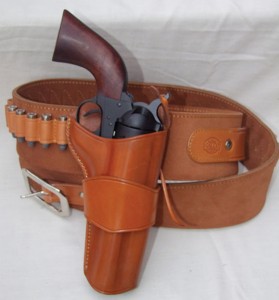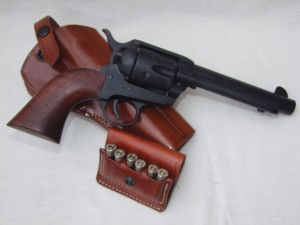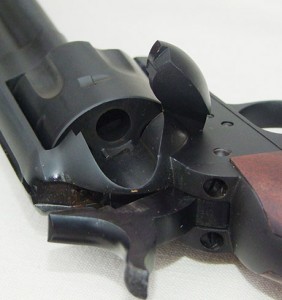by Scott Smith | Contributing Editor
When it comes to iconic firearms, the Colt Single Action Army 1873 Peacemaker is without a doubt one of them. Until recently, finding an inexpensive shooter has been relegated to the well-used market. Fortunately for those of us who would like to own a copy of the handgun that won the West, at least according to TV, Traditions (PO Box 776, Dept. TGM, Old Saybrook, CT 06475; phone: 860-388-4656; online: traditionsfirearms.com) introduced the Rawhide 1873. This is a matte black revolver with walnut grips manufactured by Pietta and it can be found online from many vendors for under $410. Before you scoff at the quality of a revolver that cost less than a car payment, remember: Traditions has been offering hunters affordable well-made muzzleloaders for many years.
When I had a chance to obtain a Rawhide, it was at the height of the ammunition crunch. I had a healthy supply of ammunition for .38special/357 magnum, so I had Traditions send a 5.5” model. The revolver also comes with a 4.75” barrel chambered in .45LC, .22LR, .22Mag and a combination .22LR/22Mag.
What you will notice about the Rawhide is the fit and finish; it is excellent. There were no tool marks, the finish was even and smooth, the cylinder locked solidly and rotated smoothly. The trigger is crisp with little to no creep and there was no slop when cocking the hammer. Next up on the initial exam of the Rawhide was the grips which fit well without any gaps and the finish was flawless. Removing and replacing the cylinder is fast and easy. My initial impression of this revolver was the fit and finish rival that of handguns costing substantially more.
Once a variety of ammunition was gathered up from my store room it was off to the range. I had several factory .38 special loads with bullet weights of 125 grains and 158 grains as well as a mix of reloads. The factory ammunition had been a purchase at a firearms auction which was sorted by bullet weight only. This gave the Rawhide a good workout at the range.
Since this was a revolver, testing the reliability was not a big issue; we loaded the cylinder with a mix of ammunition, cocked the hammer and fired it at an IDPA target at 15 yards. The rounds consistently hit about three inches below the “0” in the target. This low impact occurred with all the loads, the groups were consistent, yielding 3- to 4-inch, six-shot offhand groups. When I fired the Rawhide from the bench, these groups shrank to 2 to 3 inches at 15 yards. There was no shaving of the bullets, showing the cylinder was timed correctly.
Between strings of fire, the rounds were easy to remove from the revolver. Simply put the hammer on half-cock, open the gate and punch out the empties with the ejector rod. The ejector rod moved smoothly and knocked out each piece of brass. After that the Rawhide was loaded and ready to go again.
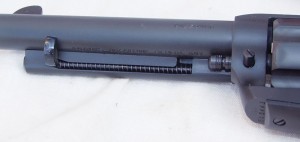
Close up of the Rawhide’s ejector, which operates smoothly, and the pins that secure the cylinder. All function properly and can be removed/installed easily.
To carry the Rawhide, I contacted Galco (2019 W. Quail Ave., Dept. TGM, Phoenix, AZ 85027; phone: 623-434-7070; online: galcogunleather.com) for a proper “cowboy” rig and a daily carry holster. When the 1880s Strongside ($85.95) and Cartridge Belt ($129.95) arrived I felt like a member of the cast of a spaghetti western of my youth. If you need a holster that conceals easier, the SAO Outdoorsman ($91.95) would be a good option. Both of these holsters allowed for quick, smooth presentations and secured the Rawhide, thanks to the hammer strap and cross strap. I must say making close fast draws from the 1880s Strongside was fun. I can see the fascination of quick draw competition and why the Single Action Shooting Society (SASS) has the membership it does.
While single action revolvers are not considered to be a modern self-defense firearm, I would not feel undergunned with one if it was all I had. There are many hunters and ranchers who use single action revolvers as their primary or secondary hunting weapon. The Rawhide would be a good option for this as well. For whatever purpose the revolver is used for I would settle on one load and adjust the height of the front sight to correct the point-of-aim/point-of-impact so it would be much closer than my sample revolver was.
Overall if you wish to have a replica of the 1873 Peacemaker without going broke, give the Rawhide serious consideration. For the money it will be tough to beat; the revolver is well made, accurate, is value-priced, and backed by a name many hunters know: Traditions.
While the Peacemaker was the “gun that won the West,” the M16/M4/AR15 has become the rifle that secures the freedom of the world. In its infancy during the early years of the Vietnam War the M16 had a reputation for being a failure. This was due to several issues created by the wiz kids of the McNamara Department of Defense—all of them for cost savings. It started with changing the powder from the original Dupont IMR powder to the powder used in 7.62X51 NATO ammunition which left more residue, aka dirt. Second, Colt touted the rifle as needing little maintenance, so to save money cleaning kits were not procured. To further compound the dirty barrel, bore, bolt carrier problem, it was decided these parts did not need to be chrome plated, like they were in the original designs. What this created was a rifle that jammed at the worst times. Once the powder was switched to the originally specified type, parts were chrome plated and GIs had cleaning kits to get rid of the gunk of combat, the M16 ran like a champ.
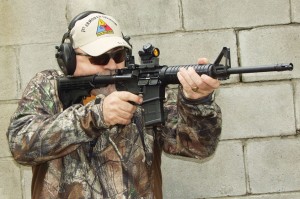
Author putting the AR556 through its paces with the Bushnell TRS25 attached. Right out of the box using Ruger’s Rapid Deploy Sight the AR553 was ready for the range, duty, plinking or 3 Gun competition.
Today this Stoner-designed firearm is the weapon that has successfully seen military service around the world. Over the last 20 years the M16/AR15 family of rifles has also become the rifle of choice for competition shooters, law enforcement officers, hunters and plinkers. This rapid rise in popularity comes from the accuracy, ease of handling the rifle, and the ability to easily customize the rifle to meet the end user’s needs. Another reason for the rising popularity of the AR15 in the civilian market is the availability of more calibers than just .223 Remington, making it ideal for hunting most game animals in the US. The last reason the AR15/M4 has become so popular is the number of veterans who are familiar with this rifle from their years in the service. With this popularity the AR15/M4’s rifles have been dubbed the Modern Sporting Rifle (MSR).
One of the most affordable entries in the MSR market is the AR556 from Sturm Ruger (1 Lacey Pl., Dept. TGM, Southport, CT 06890; phone: 603-865-2442; online: ruger.com). This is Ruger’s first entry into the gas impingement version of the AR15/M4; they introduced the SR556 (a piston driven AR) several years ago. What sets the AR556 apart from other versions of the MSR is the suggested retail price: $749. Most quality entry level rifles generally have list prices over $800. The other bonus Ruger has over most other MSRs is the AR556 has a 1 in 8” twist rate versus the standard M4 1 in 9” twist. This allows the shooter to more accurately shoot 69-grain and heavier bullets. Yes, there are very accurate rifles with the slower twist rate, but why not have a rifle that increases the odds of better accuracy in your favor out of the box?
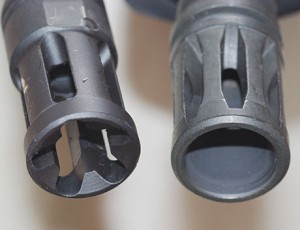
Ruger’s muzzle brake(l) compared to a standard A2 brake (r), the scallops in the Ruger brake work well to mitigate flash signature.
Other features of the AR556 are a six-position mil-spec adjustable stock, heat-resistant carbine length handguards, a 30-round PMag, Ruger Rapid Deploy folding rear sight, ergonomic pistol grip and enlarged trigger guard for ease of operation wearing gloves or if you have large hands. Ruger installs their version of the ½”-28 A2 flash hider which differs from the mil-spec version with the golf ball cutouts on each slot at the exit of the hider. These cutouts greatly reduce flash signature over the true GI birdcage. Ruger also properly stakes the chrome-plated gas key and bolt carrier. Lastly the barrel is a medium contour not a M4 profile which reduces the overall weight of the AR556 to 6.5 pounds versus 7 pounds+. This might not seem like a big deal but that half pound of weight adds up if you have to carry a carbine all day hunting, training or competing. With all of these features the AR556 is a heck of a deal.
No matter how good a deal, the rifle’s downrange performance is what matters. After quickly applying some gun oil to the bolt carrier group, we gathered some ammo and headed to the range.
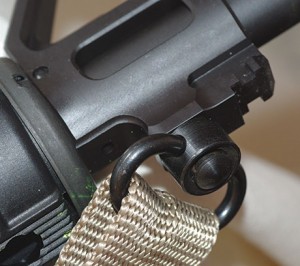
The front sight/gas block on the AR556 has a quick detach point machined in for easy attachment of a sling.
Initial testing was done at 25 yards using the iron sights and a bag of mixed factory ammunition; bullet weights ranged from 52 grains to 77 grains that were a mix of full metal jacket and hollowpoints. Surprisingly, out of the box, the factory installed sights were point-of-aim/point-of-impact with whatever I fired. The AR556 showed no preferences for manufacturer, bullet weight, or bullet design; it simply fired each round where I aimed it round after round.
Once the initial range work was done, it was time to mount a Bushnell TRS 25 red dot The TRS 25 is a 3MOA sight that retails for $147.95 and is virtually indestructible. My TRS is mounted with an old ARMS mount so it will co-witness with the iron sights.
With optics I use a 50/200 zero on my MSRs. This works well for me and my applications. Once the rifle/optic combination was zeroed it was time to shoot the AR556 for accuracy at 50 yards. This time I used known manufacturers and known bullet weights, not just a random selection of ammunition. My ammunition was a 60-grain V-Max load from Atlanta Arms & Ammo (phone:770-464-2846; online: atlantaarms.com), 68-grain hollowpoint by Black Hills (phone: 605-348-5150; online: black-hills.com), 62-grain soft point from Freedom Munitions (phone: 281-416-5493; online: freedommunitions.com) and 75-grain BTHP from Hornady (phone: 308-382-1390; online: Hornady.com). I found the AR556 not to have a preference with any of these loads. At 50 yards, shooting ten-shot groups they all averaged ¾” or less; which will more than keep hits on a target during a 3-Gun match. When I shot the rifle benched at 100 yards with the TRS25, ten-shot groups consistently hovered around three inches. While the benchrest shooters will scoff at this, bear in mind; this is a stock AR556 without magnification.
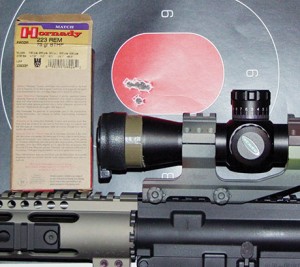
Best group with the AR556 with Weaver Kaspa mounted, ½” center to center for five shots at 100 yards from bench rest.
Knowing the rifle was capable of decent accuracy, I mounted a Weaver (phone: 800-379-1732; online: weaveroptics.com) Kaspa 1.5-6 scope on the AR556. This scope has a suggested retail price of $291.49 with an illuminated ballistic reticle and flip-up scope covers. The turrets are pull to adjust, push to lock; if you can accidentally move these turrets, you really bumped or pulled them. Once the rifle/scope were zeroed, I shot several 5-shot groups at 100 yards, the best was ½” with Hornady 75 grain match, the average of all the groups with all five test loads was just over 1”. This confirmed what I had assumed: this M4 style carbine is accurate.
Ruger’s AR556 is a reliable, affordable and accurate carbine. It would be well suited for duty, competition and general applications out of the box. With its accuracy and price point, the AR556 would be an ideal Modern Sporting Rifle to build into a 3-Gun rifle or vastly improved for duty applications. Including the Weaver Kaspa optic for a total investment of under $1500 you would have a first class rifle that I am confident would run with rifles running much more. I am confident enough in that, you will see this Ruger AR556 again in the AR issue of The GunMag with its improvements.
One last item that I wanted to include with these two time-proven firearms is a new rear sight for another time-proven warrior, the Beretta 92FS/M9. Over the years I have found that a “U” notch rear sight allows for faster front sight acquisition and aids in accuracy; none have been available until now. Wilson Combat (phone 800-955-4856; online: wilsoncombat.com) is offering their Battlesight ($49.95) that fits the Beretta’s dovetail. Some fitting is required; check out youtube for details on how to install the sight. Two of my Berettas sport these rear sights. They have been used with the factory front as well as with fiber optic front sights as my Elite II and 92A1 have dovetailed front sights. Judging from the buzz online, many other folks are installing WC Battlesights on the Beretta 92s. If you have a 92FS/M9, many pistolsmiths offer services to cut a dovetail and install fiber optic sights; Wilson Combat is one and another highly regarded operation is Allegheny Gun Works LLC (phone 724-877-6046; online: alleghenygunworks.com).

